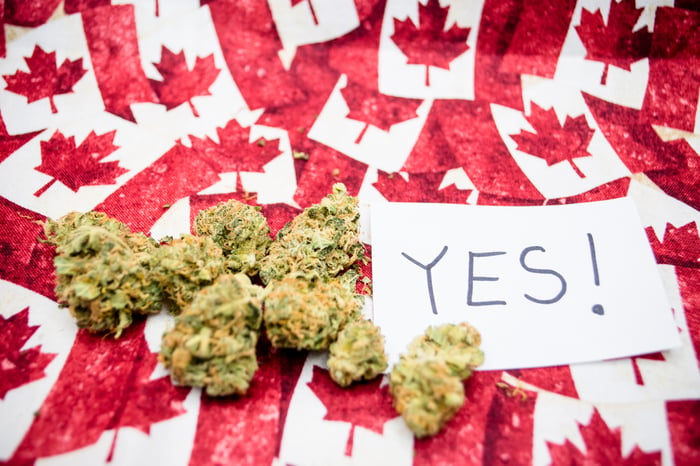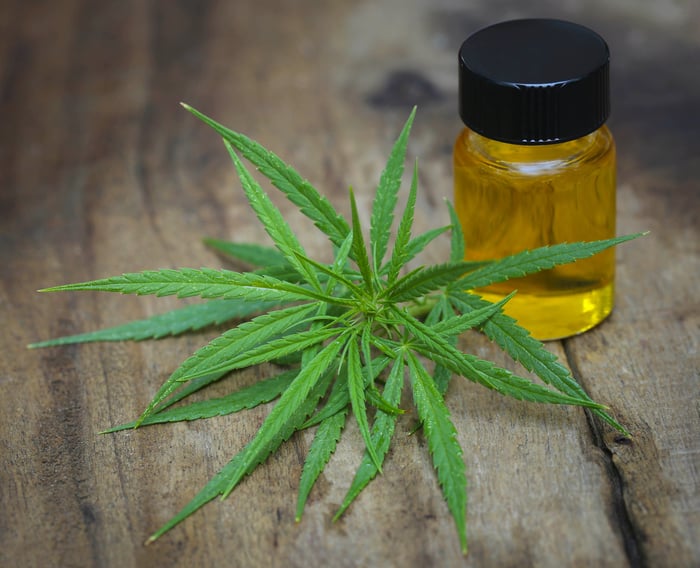Following years of discussion, and promises from Prime Minister Justin Trudeau that adult-use marijuana would be legal, we can now say it's become a reality.
On Tuesday, June 19, the Canadian Senate voted for a second time on Bill C-45, which is officially known as the Cannabis Act. With 52 votes in favor, 29 opposed, and two abstentions, and the House of Commons having already approved its own version of the bill following an initial Senate vote on June 7, the Cannabis Act now moves to royal assent. Essentially, the final stage of the legislative process where an official legalization date will be chosen.
What does this all mean for Canada and marijuana stock investors? Let's take a look.

Image source: Getty Images.
Is recreational marijuana now legal in Canada?
Technically, no, but it will be very soon. Medical marijuana has been legal in our neighbor to the north since 2001, and with both the Senate and House passing the Cannabis Act, it's just a matter of weeks until cannabis is officially legal for purchase.
When will adult-use marijuana be available?
According to commentary from Canadian Health Minister Ginette Petitpas Taylor back in February, recreational weed sales aren't expected to begin until eight to 12 weeks following royal assent. However, the Canadian government recently announced that Oct. 17 is when cannabis will officially be legal for purchase by adults. Said Taylor via a Reuters report, "They [Canada's provinces] told us they need 8 to 12 weeks following (adoption of the law) for preparatory activities to occur, such as preparatory movement of product from licensed producers to distribution and retail outlets."
What's legal and what's not, according to the Cannabis Act?
Per the bill, adults over the age of 18 are allowed to purchase marijuana, as well as possess up to 30 grams of dried cannabis for personal consumption. No decision has been made on edible marijuana as of yet, though amendments included in recent Senate debates ensure that the federal government will have the ability to address edible regulation in the future.
Similarly, there are harsh laws regulating the sale of cannabis to minors. Those found guilty of selling cannabis to those under the age of 18 could face up to 14 years in jail.
It's worth pointing out that there's still quite a bit of legislation to be resolved. In particular, legislation that would grant law enforcement additional authority to conduct impaired driving tests for those suspected of driving under the influence of marijuana have yet to be passed.

Image source: Getty Images.
Is legalization the same throughout all of Canada's provinces?
No. Just as we've witnessed jurisdictions within legal states in the U.S. lay out regulations on cannabis dispensaries and legality, provinces also have the ability to regulate marijuana as they see fit. As an example, even though the Cannabis Act allows adults over the age of 18 to purchase cannabis legally, every province except for Alberta has set the legal age to 19 and over. Additionally, Saskatchewan has chosen to only allow private retailers and online sales, whereas most other provinces are allowing government-operated retail locations and online sales.
What sort of taxes can consumers expect to pay on legal pot?
As was hashed out in October of last year, legal marijuana will face a tax of 1 Canadian dollar per gram on cannabis costing up to CA$10 per gram. On more expensive cannabis strains, the tax will be a flat 10%. Compared to the alcohol tax in Canada, which ranges from around 50% on beer to as much as 80% on liquor, cannabis consumers (and the industry) have it made.
How does taxation work between the provinces and federal government?
In December 2017, the Canadian federal government worked out a two-year tax-sharing agreement with all but one province (Manitoba) that'll wind up sending 75% of collected excise tax revenue to the individual provinces, with the remaining 25% going to the federal government, up to CA$100 million a year. If tax collection were to exceed this amount, the provinces would get 100% of the excise tax overage. Since the provinces are on the frontlines of policing cannabis regulation, this skewed excise-tax share make sense.

Image source: Getty Images.
How much marijuana are Canadians expected to buy?
Put plainly, the demand outlook is total guesswork at this point given that no developed country has ever legalized marijuana before. While a number of early reports called for annual demand in the neighborhood of 800,000 kilograms of cannabis, a more recent estimate from Health Canada suggests Canadians could purchase 1 million kilograms of cannabis on an annual run-rate basis.
Will Canada's marijuana industry be undersupplied or oversupplied?
Initially, Canada is expected to face a pot shortage. Despite rapid capacity expansion by the country's growers, constructing or retrofitting greenhouses, planting the crop, and harvesting, takes considerable time and money. Most growers have staggered completion dates for their key projects that range between the summer of 2018 and the end of 2020.
However, once 2020 rolls around, the domestic marijuana industry could be grossly oversupplied. Though estimates are fluid, the eight-largest growers appear to be on track for a combined 1.8 million kilograms of production by 2020. Once smaller licensed cultivators are added in, Canada could be looking at 2.4 million to 2.5 million kilograms of annual cannabis production.
How will Canadian growers adjust to the potential for oversupply?
Though the Canadian market is expected to add billions in annual revenue from the legalization of pot, growers are going to have to find a way to move what could be well in excess of 1 million kilograms of oversupply. They'll do this by focusing on the more than two dozen foreign markets where medical marijuana has been legalized. These foreign countries, like Germany, are leaning on countries like Canada to supply their medical weed industries via exports.

Image source: Getty Images.
Is legalizing weed all about dried cannabis?
Surprisingly, no. Growers are attempting to diversify their product line as much as possible in anticipation of marijuana officially being legalized. Within the U.S., pot prices have plunged in each and every legal state a few years following adult-use legalization as marijuana has become commoditized. The same thing will likely happen in Canada. That's why niche products like oils and extracts, which have significantly higher price points and margins, are expected to be the real profit producers for marijuana stocks.
Are there any marijuana value stocks?
Keeping in mind that "value" is in the eye of the beholder, there are a small handful of Canadian cannabis growers that are considerably cheaper than their peers. CannTrust Holdings (CNTTQ), which generated more than half of its sales during its fiscal third quarter from cannabis oils, is one such company. Currently valued at just 26 times forward earnings, and likely to generate triple-digit sales growth in 2018 and 2019, CannTrust's PEG ratio is probably well below 1 (there are no five-year growth estimates from Wall Street, so this is an educated guess). Any PEG ratio below 1 is considered to be a good value, making CannTrust particularly attractive from a fundamental perspective.
Needless to say, things are changing rapidly in the legal cannabis landscape.




